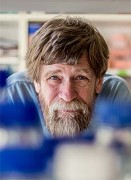Authors
J Tachezy1; V Žárský1; E Nývltová1; I Hrdý1; 1 Charles University in Prague, Czech RepublicDiscussion
Conoza is an intriguing group of free living and parasitic protists that includes both aerobic (Eumycetozoa) and anaerobic (Archamoebae) members. Phylogenetic analysis suggested that Archamoebae evolved from aerobic ancestor, which makes amoebozoans very attractive for tracing evolutionary history of cell adaptation to anaerobic niches and parasitic style of life. The adaptation to anaerobiosis included the loss most of canonical mitochondrial and peroxisomal pathways and the acquisition of enzymes required for anaerobic energy metabolism. Comparative analysis of genomes of Amoebozoa group members including fee-living Mastigamoeba balamuthi and parasitic Entamoeba histolytica with selected opisthokont genomes revealed a major loss of genes related to mitochondrial metabolic functions during the transition to anaerobic lifestyle. This loss was probably compensated by acquisition of variety of bacterial genes by lateral gene transfer. Next we specifically focused on metabolism of M. balamuthi and E. histolytica. The common features for both organisms include (i) acquisition of anaerobic energy metabolism including PFO, hydrogenase, acetyl CoA synthetase (ii) iron-sulfur cluster assembly machinery of bacterial type (NifS, NifU), and (iii) sulfate activation pathway. However, while in M. balamuthi, the enzymes of energetic metabolism and NIF pathway have a dual localization in the cytosol and hydrogenosomes (anaerobic mitochondria producing hydrogen), these pathways are not present in mitosomes (reduced mitochondria that don't generate energy) of E. histolytica. Unlike mitosomes, the hydrogenosomes of M. balamuthi retain several canonical mitochondrial components including TCA enzyme malate dehydrogenase, respiratory complex II, and the glycine cleavage system. We propose that the more complex hydrogenosome in free living M. balamuthi represents the intermediate step between the ancestral aerobic organelle and highly reduced mitosomes in parasitic Entamoeba histolytica. 

